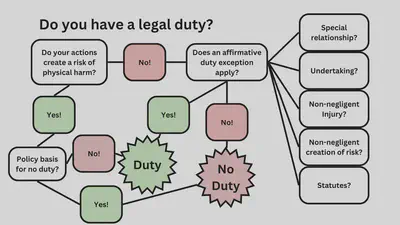Review Exercises
Some logistics
Makeup Class: Tuesday, November 28 from 8:15am-9:30am in this classroom.
Office hours today 12pm to 1pm
Additional office hours on Tuesdays: Tuesday, November 21 from 12pm to 1pm Tuesday, November 28 from 12pm to 1pm
Midterm information
4 hour exam on December 4, 2023. Worth 25% of your grade.
Mix of short answer and essay questions. No multiple choice.
You will be provided with an appendix that includes:
— A list of major cases
— Legal rules that you are not expected to have memorized
[fit] You should be worried.
As you study:
- Connect with your core values.
- Discern your immediate goal.
Why take this preliminary step?
Connecting to core values makes the work easier and more fulfilling.
Discerning a goal allows you to focus your attention on what matters.
There is no escape.
Anxiety is a very bad, no good motivator.
Exercise 1
You are a Justice in the Supreme Court of Nebraska who was part of the majority in Heins v. Webster County. You receive a letter from a colleague, Dale Fahrnbruch, who was part of the dissenting opinion in Heins (which we did not read for class). The letter describes a case that is now being litigated in the wake of the Heins opinion.
A plaintiff was playing on an outdoor asphalt YMCA basketball court, fell, and was injured. The plaintiff was not a member of the YMCA and did not pay dues to the YMCA. The plaintiff sued the YMCA. The YMCA motioned for summary judgment, contending that the YMCA did not owe the plaintiff a duty of care. Prior to the Heins ruling, the trial court would have followed the traditional rule, found the plaintiff to be a licensee, and granted the defendant’s motion for summary judgment. Instead, the trial court followed the Heins ruling, found that the YMCA owed the plaintiff a duty of reasonable care, and denied the defendant’s motion for summary judgment.
Your colleague, Dale, has written you this letter to remind you that the Heins opinion now subjects the YMCA to lawsuits holding them to a duty to treat uninvited users of their facilities with the same standard of care as the paying members of their institutions. He tells you that this case is “more than enough proof that the Heins opinion was wrongly decided and has had the expected effect of socializing the use of privately owned property. As a result, public and private institutions, as well as residential homeowners, must be especially aware of unknown, uninvited individuals who take advantage of their land and facilities.” Dale implores you to reconsider your position in Heins and to cast your vote the other way if the issue comes before the court again.
How do you respond?
Please note that your response here is a letter to a colleague. You are not writing a legal opinion. You are writing a response to a colleague who is concerned about the social consequences of the Heins opinion. Assume that your letter will be preserved and may be made public at some point in the future.
Traditional View
| Type of Visitor | Definition |
|---|---|
| Trespasser | Intruder |
| Licensee | Social guest |
| Invitee | Business guest or general public (if land opened to public) |
Duties Owed — Traditional View
Trespasser
- duty not to intentionally or wantonly cause injury
- no duty of reasonable care (with handful of exceptions)
Licensee
- no duty to inspect or discover dangerous conditions
- duty to warn or make known conditions safe
Invitee
- duty to inspect and discover dangerous conditions
- duty to warn or make conditions safe
Modern View
| Type of Visitor | Definition |
|---|---|
| Trespasser | Intruder |
| Everybody else | Not a trespasser |
Duties Owed — Modern View
Trespasser1
- duty not to intentionally or wantonly cause injury
- no duty of reasonable care (with handful of exceptions)
Everybody Else
- duty of reasonable care
Exercise 2
You are a trial court judge in the state of Loyola. The facts of a case before you are as follows. A patient had been diagnosed as legally blind and had stopped driving as a result. At a routine eye appointment, the patient’s optometrist told him that his vision had improved enough for him to drive again. The patient resumed driving and shortly thereafter crashed into a horse-drawn hay trailer, killing one passenger and injuring the other four.
The passengers have sued the optometrist for negligence. The optometrist has moved for summary judgment on the grounds that she had no duty to the plaintiffs.
How would you rule on the motion? Include your reasoning. You should be aware that the Supreme Court of Loyola recently adopted the holding and reasoning of the Tarasoff opinion regarding a psychiatrist’s duty to third parties. Loyola has likewise adopted the Rowland factors for determining whether an affirmative duty exists beyond the traditional common law exceptions.

Rowland Factors
- foreseeability of harm
- certainty of plaintiff’s injury
- connection between defendant’s conduct and plaintiff’s injury
- moral blame
- policy of preventing harm
- burden to defendant
- consequences to community
- availability of insurance
Or in California and the Third Restatement, a “flagrant” trespasser rather than just a plain old trespasser ↩︎